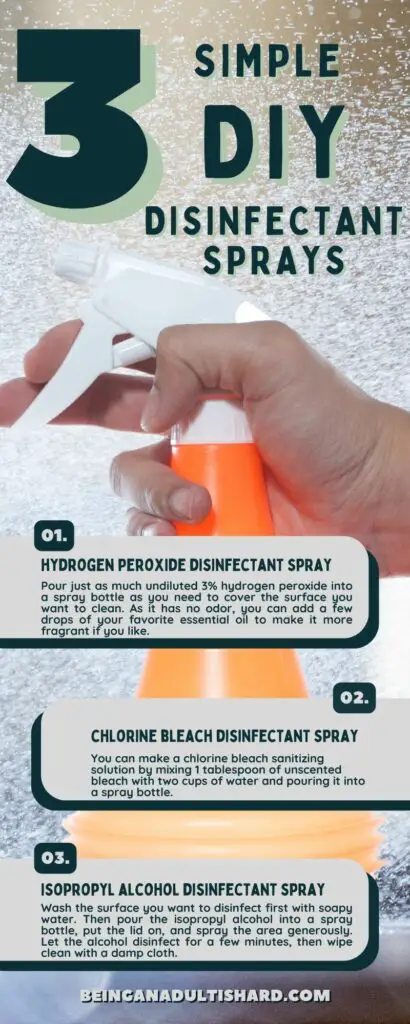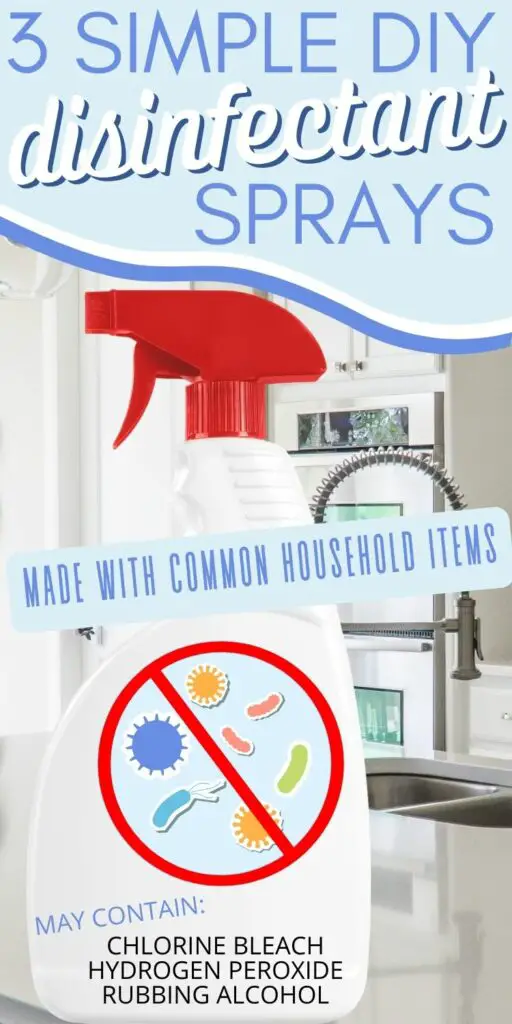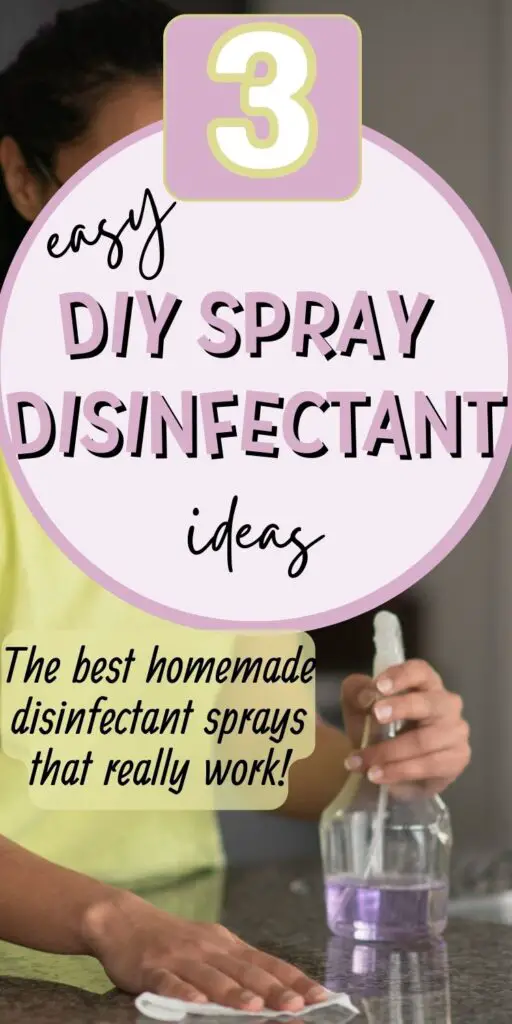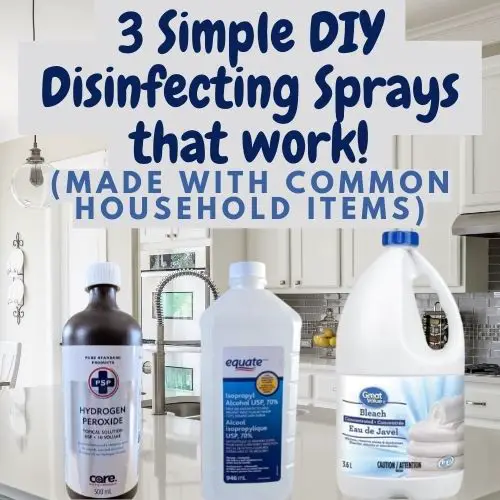Looking for a homemade sanitizing spray? You can make your own DIY disinfectant spray with simple ingredients you already have in your home!
The other day, I decided to do some decluttering in the kitchen. While I love my Instant Pot, I haven’t used it in a while. It was stored in a back corner of the countertop so I thought I would move it into the basement to declutter and open up some more space on the counter.
When I moved the Instant Pot, I discovered that mice had made the space behind it their new hangout. I found kitchen scraps, other scavenged items, and droppings and was horrified! I immediately went to make an effective DIY spray disinfectant to make sure to get rid of all that germy ickiness.
With no bleach on hand and only a small amount of hydrogen peroxide, I found a full jug of 70% isopropyl alcohol in the bathroom so I decided to go with that and had the Instant Pot and counters cleaned and disinfected within minutes. Then we set the mouse traps.

RELATED POST: List of things to declutter in your home
As an Amazon Associate I earn from qualifying purchases. This means if you click on a link and buy something I’ve recommended, I get a small commission at no additional cost to you. You can see my full Disclosure Policy here.
Steps to disinfect and sanitize your home
You can’t just spray a disinfectant on surfaces like countertops or high touch surfaces. The first step is to clean them with soap, water and a cloth to remove dirt, bacteria and other germs. Then you can use the spray solution on the surface and let sit to kill any remaining germs.
The difference between sanitizing and disinfecting
Sanitizing refers to the process of minimizing the number of bacteria, viruses, and other germs to an acceptable level. Using diluted spray on surfaces usually results in this level of cleanliness.
Disinfecting is the process of killing all germs that you spray directly with the proper disinfectant solution.
Make your own disinfectant spray
If you don’t have Lysol spray, here are three common household items you can use to make your own safe and effective DIY spray disinfectant cleaner:
- undiluted hydrogen peroxide;
- or undiluted isopropyl alcohol;
- or by using a chlorine bleach and water sanitizing solution.
When making your homemade disinfecting spray, never mix any of these ingredients together. You could produce toxic fumes that can be deadly.
RELATED POST: 21 Unbelievable DIY Cleaning Uses for Citric Acid Powder

DIY hydrogen peroxide disinfectant spray
Pour just as much undiluted 3% hydrogen peroxide into a spray bottle as you need to cover the surface you want to clean. As it has no odor, you can add a few drops of your favorite essential oil to make your DIY disinfecting spray more fragrant if you like.
Clean the surface with soap and water first and wipe to dry. Then spray the countertops generously with the hydrogen peroxide disinfectant spray. Let it sit for 5 minutes and either wipe up the excess or you can let it air dry.
Note that you can’t store excess hydrogen peroxide in a spray bottle as it is sensitive to light and breaks down over 24 hours, making it no more effective than water. It’s better to keep it stored in the brown bottle you purchased it in.
Do not regularly use undiluted hydrogen peroxide as a sanitizer on natural stone as regular use can damage the finish. It’s better to use a rubbing alcohol solution on natural stone as it won’t damage the finish.
RELATED POST: 53 Hydrogen peroxide hacks you need to know
DIY bleach-based disinfectant spray
Household chlorine bleach is a strong and effective disinfectant as it kills bacteria, fungi and viruses. This is the sanitizing method recommended by the CDC to effectively prevent the spread of illnesses and diseases. You can make a chlorine bleach sanitizing solution by mixing 1 tablespoon of unscented bleach with two cups of water and pouring it into a spray bottle.
First, clean surfaces with soap or detergent before disinfecting with your bleach disinfectant spray. Then spray the bleach solution generously on the surface, let sit for at least a minute or two, then rinse with clean water.
If you don’t like the smell of bleach, do not add any fragrance as it may react with the bleach. Air out the area by opening some windows for a few minutes.
You will have to make a new diluted bleach solution each time you disinfect as bleach solutions are not effective after being mixed with water for over 24 hours. . Only make as much as you can use at a time.
Do not use bleach disinfecting solutions on porous surfaces such as unsealed natural stone like granite or wood or you may damage the finish over time.
Using undiluted bleach is not recommended for any disinfectant purposes, as it can easily irritate your eyes, skin and throat. Undiluted bleach doesn’t have any more disinfecting power than diluted bleach, and it can damage the surface you are trying to disinfect.
RELATED POST: 42 Dawn Dish Soap Uses You Never Thought Of
DIY disinfectant spray with alcohol
If you choose to use isopropyl alcohol as your disinfectant, it’s best to use undiluted 70% strength alcohol. Rubbing alcohol is a good disinfectant as it kills organisms such as bacteria, fungi and many viruses.
You should always wash the surface you want to disinfect first with soapy water. Then pour the isopropyl alcohol into a spray bottle, close the spray bottle tightly, and spray the area generously. Let the alcohol disinfect for a few minutes, then wipe clean with a damp cloth. Here are 40+ rubbing alcohol hacks for more ideas for rubbing alcohol.
Although isopropyl alcohol has a pungent odor, it should evaporate and dissipate after a few minutes. I don’t recommend adding any fragrance as you would need a lot to overpower the alcohol smell.
Don’t use isopropyl alcohol on painted, shellacked, lacquered, or varnished surfaces, including treated wood as it is a solvent and can liquify varnishes or finishes.
You can’t use alcohol like vodka instead of rubbing alcohol to disinfect surfaces. Most regular consumable alcohol contains no more than 40% alcohol content, which isn’t high enough to kill bacteria, viruses or fungi and truly disinfect surfaces. But you can use it to sanitize surfaces.
RELATED POST: 40+ Rubbing alcohol hacks to make life easier

Make your own disinfecting wipes
You can use rubbing alcohol to make your own disinfectant wipes as you need them. All you need is some rubbing alcohol and paper towels. First, cut a roll of paper towels in half with a sharp knife. Then, pour the rubbing alcohol over the paper towels until they are completely soaked. Finally, store your DIY disinfectant wipes in an airtight container and use them to clean and disinfect high-touch surfaces around your home. You could even use them as alcohol prep pads. It’s a quick and easy way to stay clean and healthy!
What is the most effective natural disinfectant?
The most effective natural disinfectant is hydrogen peroxide, a natural chemical compound that can be used as an eco-friendly alternative to bleach. It breaks down into simple water and oxygen, making it safe for people, pets and the environment.
RELATED POST: How to make all purpose cleaners
What is the best homemade disinfectant spray?
The best homemade disinfectant spray is undiluted rubbing alcohol in my experience. Rubbing alcohol is a great disinfectant spray that it is very active against a wide range of microorganisms, including bacteria, yeasts, fungi, viruses, and spores. It doesn’t require a long exposure time and also evaporates quickly.
RELATED POST: 19 mind-blowing uses for Windex (and 6 things you shouldn’t use it for)
Does vinegar disinfect and sanitize?
While vinegar can help eliminate odors and effectively remove dirt, it has limited disinfectant uses. It does have disinfectant properties that can destroy some bacteria and viruses but is not recommended for use as a surface disinfectant as you need to allow at least a half hour of exposure for it to sanitize.
Using a homemade disinfectant is a great way to keep your home clean and healthy. Use one of these DIY disinfectant sprays during cold and flu season for an easy and effective way to kill germs and prevent the spread of illness.
RELATED POST: Cleaning hacks for lazy people (like me)


